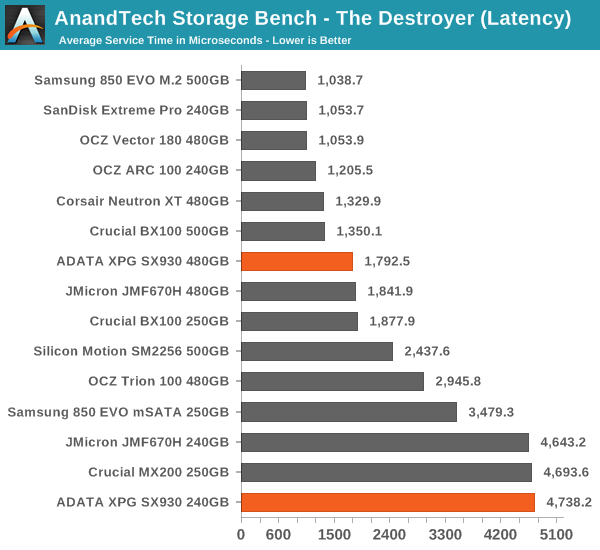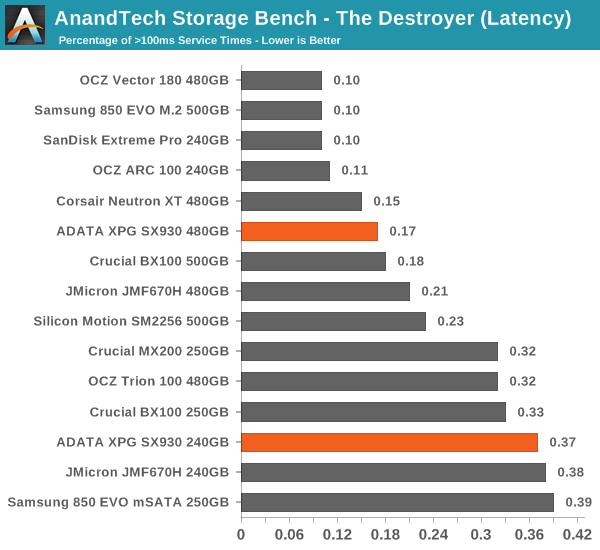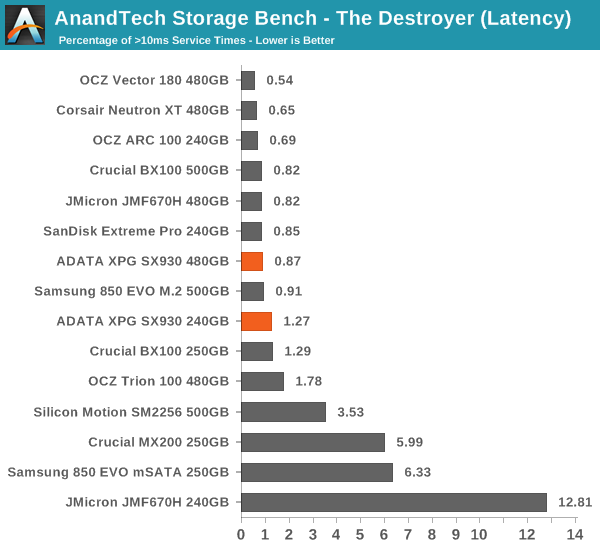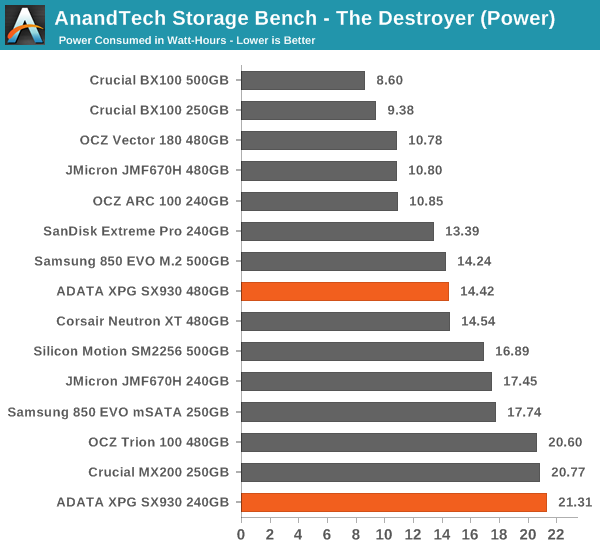ADATA XPG SX930 (120GB, 240GB & 480GB) SSD Review: JMicron JMF670H Debuts
by Kristian Vättö on July 16, 2015 10:00 AM ESTAnandTech Storage Bench - The Destroyer
The Destroyer has been an essential part of our SSD test suite for nearly two years now. It was crafted to provide a benchmark for very IO intensive workloads, which is where you most often notice the difference between drives. It's not necessarily the most relevant test to an average user, but for anyone with a heavier IO workload The Destroyer should do a good job at characterizing performance. For full details of this test, please refer to this article.

The SX930 doesn't perform too well in our The Destroyer trace. If this was a value-oriented drive, I would say the performance is decent, but any drive that is focusing on the higher-end segment should outperform the BX100 and 850 EVO to have any chance of being competitive.


The number of high latency IOs isn't particularly large, but again the SX930 is only competitive against the value drives.

Power consumption is fairly average for the 480GB model, but the 240GB consumes substantially more due to its lower performance.











67 Comments
View All Comments
bill.rookard - Thursday, July 16, 2015 - link
It is more of a power-user scenario. I have a pretty fast desktop (i5-4670k, 16GB ram, Gigabyte Gaming-5 mobo) paired with an older (!) Samsung 830 128Gb boot drive. The computer, once you get past the POST, boots in seconds. Your average user would never notice a faster boot, since it's so bloody quick already.DIYEyal - Monday, July 20, 2015 - link
SSDs are far more than just fast boot.frenchy_2001 - Thursday, July 16, 2015 - link
As Anand used to repeat in most of its SSD tests, there is very little difference for typical client usage between SSDs. There are order of magnitudes between SSDs and HDDs (particularly useful for random access latencies), but once that jump is made, there is very little difference for client usage.Just check the "Storage Bench Light Latency" graphs. This is the ranking for typical client usage and most SSDs are in the same range.
Only enterprises and power users will really benefit from PCIe/NVMe storage. For the rest of us, any modern SSD is good enough.
Stochastic - Friday, July 17, 2015 - link
To me this raises the question of what's next in client computing. Any half-decent PC today with an SSD already excels at most consumer tasks--web browsing, office applications, light photo editing, 1080p video, etc. Compute intensive tasks such as computer vision and natural language processing are being pushed to the cloud. Gamers have faster GPUs and next-generation displays (OLED, 4K, wide-gamut, adaptive V-sync) to look forward to, but aside from that there's nothing else in the horizon that gets me excited. Maybe VR is the next big thing?Kristian Vättö - Friday, July 17, 2015 - link
Unified memory architecture (i.e. no more memory and storage, just one type that serves as both) is really the next big thing. We'll likely see something in that front in the early 2020s.AnnonymousCoward - Saturday, July 18, 2015 - link
Are you saying a non-volatile technology will replace DRAM in 5 years? How could that possibly happen?Kristian Vättö - Saturday, July 18, 2015 - link
Not replace right away, of course, but in five years time the next generation non-volatile memory (ReRAM, NRAM, MRAM or whatever it ends up being) should start to be in meaningful production volume. Once that happens it will slowly start to replace DRAM and NAND, although that transition may easily take a decade, but some enterprise applications will probably take advantage of a unified memory architecture rather quickly.AnnonymousCoward - Tuesday, July 21, 2015 - link
Huh. I haven't heard of all 3 of those. But without even knowing about them, I can say in general it will be damn hard to beat DRAM performance and density/cost. Maybe in 2030.ATC9001 - Thursday, July 16, 2015 - link
Is there ever going to be a drive that challenges the EVO for price and performance? It competes with higher end drives, but is nearly the cheapest available...Refuge - Thursday, July 16, 2015 - link
Honestly idk...Samsung is very well set up in the SSD space right now, they have their own in house controller that is a very solid performer, and they are completely vertically integrated with some of the best fabs around.